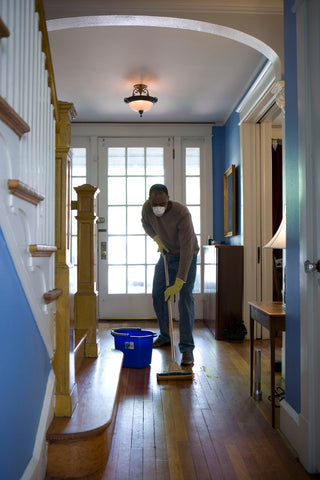Mould is a living, growing organism. Even when treated, if the conditions are right, think moisture and humidity, mould will grow. To make sure mould doesn’t undo all the hard work you put into getting rid of it, here are some simple steps that you can undertake now to prevent and slow the return of mould.

How to Tackle Mould
These 10 simple steps centre around modifying the home environment to make it less attractive to mould. They are easy to do, cost nothing and can be done at any time.
1. Open Windows and Doors - This will allow fresh air to circulate through the home during the day and reduce any moisture build-up, especially from bathrooms and kitchens. Even if it’s cold outside, still open even a small window particularly in the bathroom to let the moisture escape. Remember to keep the bathroom door closed to the rest of the house and allow the moisture to exit through the window not the rest of your home.
2. Turn on Fans - Always run your bathroom fan when in use and leave it on until the moisture has evaporated. Depending upon how much moisture is in the air you can also make use of your kitchen exhaust fan and any other free-standing fans to ventilate your home.
3. Wipe Down Wet Surfaces - Especially after a bath or shower, get into the habit of wiping down the shower screen, bathtub and vanity with each use. Make it easy by leaving a cloth specific for the purpose on the towel rail to help you remember and so you won’t have to go searching for a cloth every time. Use this strategy in the kitchen and laundry too, whenever there is steam or condensation collecting on splashbacks or windows.
4. Dry the Air – Using heat to dry the air can be done with freestanding heaters used in a specific room, ducted heating or hydronic heaters left on to keep the air dry.
5. Use Sunlight - It is both drying and warming. Drawback curtains and pull up blinds, remove anything blocking the sun from entering through your windows. Move large items such as sofa’s off walls, leaving some space for ventilation. Any items in your home that have mould on them or just a mildew smell should be moved out during the day into full sun where possible.
6. Remove Wet Items - If your home is prone to mould or the environment is humid, air dry wet items outside. Don’t leave wet towels or other items hanging in the bathroom or wet clothes in the laundry. Promptly take them outside or put in the dryer. Leave wet raincoats and shoes to dry outside too.
7. Check the Plumbing - This is just good housekeeping as leaky roofs and damp in walls can do long term damage to your home and your health. Do a thorough search of the home and scan for any leaks or wet areas. If you believe you have a problem consult the appropriate tradesperson without delay. You can and should also do this if you're in a rental property and have the agent or landlord rectify the problem.
8. Remove Clutter - The more items in your home, the more surfaces for mould to latch on to. Put the rubbish out and tidy up daily as maintenance. Remove excessive items from the home. Items in good condition can be sold or donated. Reducing clutter will also have the benefit of less dust triggering allergies in the home as well as a feeling of space and calm.
9. Go Outdoors - As well as removing excess clutter from inside the home, check the outside too. Items stacked around the outside of the home such as timbers or garden waste will encourage dampness and mould growth. Be sure to regularly tidy up and remove things when they are no longer needed.
10. Treat Mould and Mildew - Oil of Cloves will kill mould and spores on surfaces in your home. Our best selling product for treating mould is Oil of Cloves for Mould 100% pure. Spray regularly during times of high dampness and humidity and use as a preventative at other times. Prevention is key and how often will depend on your home and your climate and you will be the best judge as to how regularly to treat your home to keep mould at bay.
Tackling mould in your home as soon as it appears is core to keeping it from taking hold and ruining your possessions and your health.

Leave a comment